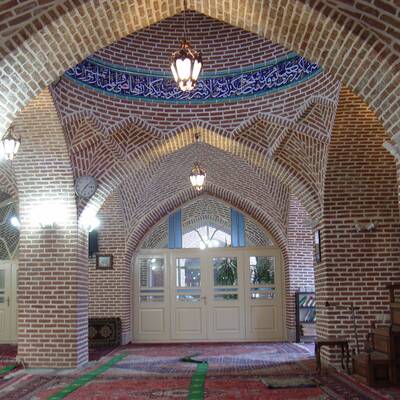Arg of Tabriz also known as Arg Alishah, Arg-e Alishah, Arch of Alishah, Arg Citadel, and with its mosques, religious schools, public baths, historical houses, and old quarters, the Tabriz Arg hosts many international and domestic tourists every year. The Bazaar of Tabriz, a covered one, is famous all around the world. There are also other cultural centers like Blue Mosque, Rab'-e Rashidi, or El Goli Building.
In the city center, the south side of Imam Khomeini Street, there is a high wall with a mihrab which reminds us of Ivan of Kisra. Being called Masjid Ali-Shāh, or Arg of Tabriz, the monument was built in the eighth century AH under the orders of Taj al-Din Ali-Shāh Gilani, the minister of Abu Sa'id Kahn Bahador who was buried there, and the architecture was The Master, Falaki Tabrizi. According to some of the historians, such as Hamdallah Mustawfi, they hurried to build the building so it collapsed and it was never finished. However, its greatness and decorations (Marbles and tiles) were fascinating enough that many travelers or historians talked about it such as Ibn Battuta was a Moroccan explorer, Naser al-Din Kitib Monshi, Katib Chebli (who accompanied Sultan Murad the forth in his voyage to Tabriz), Jean Chardin, the French traveler, and Dieulafoy, the French archaeologist.
There are two hypotheses about its date, some says it was Taj al-Din Ali-Shāh who has built it from the beginning, while others, like Ali Akbar Sarfaraz, the archaeological excavator, and Wolfram Clyse, the famous archeologist, believe that this monument consists of two sections which northern section is older and after some times, the southern section was built. That means Taj al-Din Ali-Shāh renovated the enormous and ancient Citadel, then added the southern section and chewed the whole complex to a religious one.
This seven hundred-years old monument passed history of ups and downs, a part of which destroyed during Safavids. At the beginning of the Qajar dynasty, it was a place for Army ammunition. At the end of this dynasty, the complex was a shelter for constitutionalists and revolutionaries like Satar Khan and Bagher Khan. Reza Shah Pahlavi established some gardens around it, so it was called National Garden. After the revolution of the Islamic Republic, it changed again to a mosque for Friday prayer. A huge part of it was by dynamite and other explosives to establish some industrial sheds and now, there remains just a high wall and a beautiful Mihrab.


..jpg)
